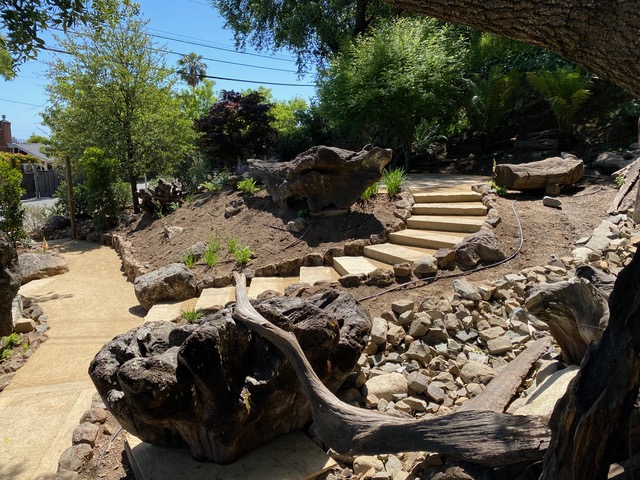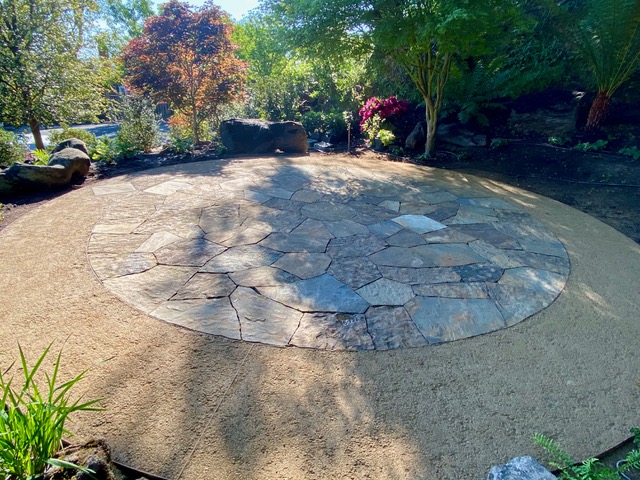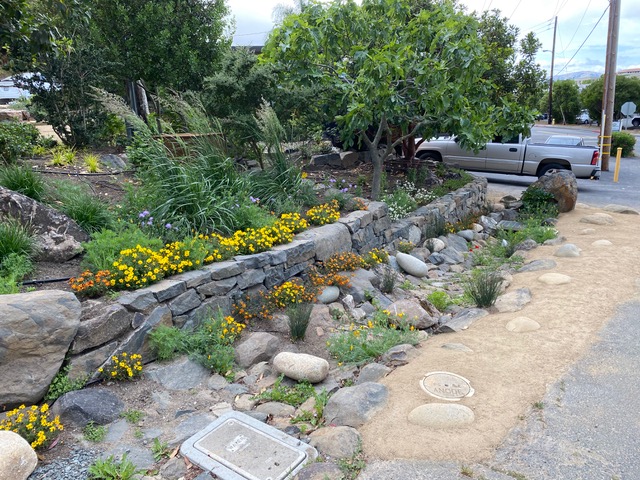On paper, summarizing who Dave Washer is and what he does should be easy. It’s not.
Limiting him to his occupation (landscape design and build contractor) would be doing a disservice to his creativity, his knowledge of—and respect for—the natural environment, and his innate sense of the spiritual threads that connect us as people, animals, and plants.
So, yes. While Dave Washer is a landscape design and build contractor, he is so much more than that.
All images property of – and courtesy of – Dave Washer.
The GraniteCrete pathway in the upper-left image would later be covered with a bed of mulch after a discussion with Public Works.
I met with Washer at a property in Corte Madera he’s been busy transforming over the course of a month. The work isn’t done yet, and will likely take the rest of the summer.
While we walked the property, he described his basic formula for planning a landscape:
- Large and beautiful specimen trees
- A variety of grasses
- The use of pollinator perennials both as “weeds” and to provide a splash of color (”See how it looks like a meadow?” he gestured to where grasses and perennials swayed as a gentle breeze moved through them; I had to admit that it did)
- Pathways and terraces that weave throughout, helping create defined spaces.
The Importance of Defining Space
As we stood inside a fenced nook near the front of the property, he elaborated on this last point. Having defined spaces is a guiding principle for all landscapes he designs, as these establish the “bones” of a design. “You need strong foundations when you’re creating something – whether that’s a habitat, something dramatic, or something whimsical. If you can’t have it last for ten, twenty, thirty years… it’s kind of useless to try to even go there.”
He continued, “You can define space in different ways: You can use pathways, create alcoves, build walls, et cetera.” During our tour, he pointed out examples: dry-stack rock walls, strategically placed seating areas, and pathways that guide visitors from one area to another. There aren’t any doorways, but there’s a distinct sense of moving from room to room.
Remaining Connected to Nature
Washer also wants his designs to feel connected to the natural habitat “so that when a landscape is finished, it looks like it was there long before the house was built.” To accomplish this, he often uses GraniteCrete because it allows the surrounding landscape to continue “being in a relationship with nature.”
Washer acknowledged that using paving materials such as concrete or tile are fine close to a building. However, as the landscape moves away, it’s important to use material that has an aesthetic quality and is able to be out in a natural setting. GraniteCrete, he says, fits this need due to its structural integrity and overall look. Since he began using it roughly three years ago, he’s become a Certified Installer and has used GraniteCrete for pathways, stairs, as “grout” in between stones, and to create a more firm surface beneath a bed of mulch.
Practicing Sustainability
The fact that GraniteCrete can be recycled also fits Washer’s overall landscaping approach. While it’s not explicitly stated, it’s clear that sustainability is important to him, illustrated by items scattered throughout that he’s given a second life: We traversed a pathway paved with unused headstones, admired “sculptures” crafted from naturally-fallen and harvested redwood trees, and visited another garden that uses San Francisco cobblestones as edging.
Near the end of our time together, Washer and I talked about how he got his start designing landscapes in 2001. To secure his first job, he took a photo of the client’s front yard and did some work in Photoshop to show what he would convert it into. It impressed the client – who referred to him as a ‘hardscape artist’ – and he got the job. “I had no idea what I was doing then,” he admitted. Looking around at what he’s in the process of creating nearly two decades later, it’s safe to say that’s no longer the case.


